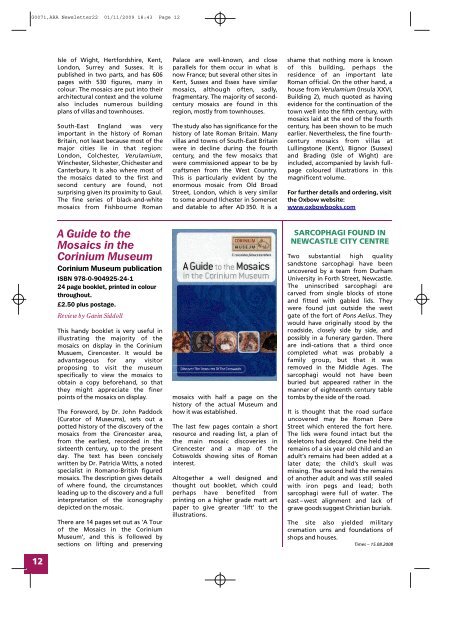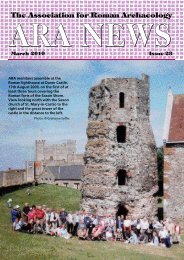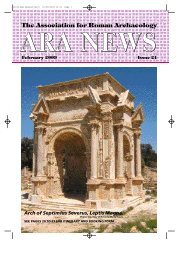G0071,ARA <strong>Newsletter</strong><strong>22</strong> 01/11/2009 18:43 Page 12Isle of Wight, Hert<strong>for</strong>dshire, Kent,London, Surrey and Sussex. It ispublished in two parts, and has 606pages with 530 figures, many incolour. The mosaics are put into theirarchitectural context and the volumealso includes numerous buildingplans of villas and townhouses.South-East England was veryimportant in the history of <strong>Roman</strong>Britain, not least because most of themajor cities lie in that re g i o n :London, Colchester, Ve ru l a m i u m,Winchester, Silchester, Chichester andCanterbury. It is also where most ofthe mosaics dated to the first andsecond century are found, notsurprising given its proximity to Gaul.The fine series of black-and-whitemosaics from Fishbourne <strong>Roman</strong>Palace are well-known, and closeparallels <strong>for</strong> them occur in what isnow France; but several other sites inKent, Sussex and Essex have similarmosaics, although often, sadly,fragmentary. The majority of secondcenturymosaics are found in thisregion, mostly from townhouses.The study also has significance <strong>for</strong> thehistory of late <strong>Roman</strong> Britain. Manyvillas and towns of South-East Britainwere in decline during the fourthcentury, and the few mosaics thatwere commissioned appear to be bycraftsmen from the West Country.This is particularly evident by theenormous mosaic from Old BroadStreet, London, which is very similarto some around Ilchester in Somersetand datable to after AD 350. It is ashame that nothing more is knownof this building, perhaps theresidence of an important late<strong>Roman</strong> official. On the other hand, ahouse from Verulamium (Insula XXVI,Building 2), much quoted as havingevidence <strong>for</strong> the continuation of thetown well into the fifth century, withmosaics laid at the end of the fourthcentury, has been shown to be muchearlier. Nevertheless, the fine fourthce n t u ry mosaics from villas atLullingstone (Kent), Bignor (Sussex)and Brading (Isle of Wight) areincluded, accompanied by lavish fullpagecoloured illustrations in thismagnificent volume.For further details and ordering, visitthe Oxbow website:www.oxbowbooks.comA Guide to theMosaics in theCorinium MuseumCorinium Museum publicationISBN 978-0-904925-24-124 page booklet, printed in colourthroughout.£2.50 plus postage.Review by Gavin SiddollThis handy booklet is very useful inillustrating the majority of themosaics on display in the CoriniumMusuem, Cirencester. It would beadvantageous <strong>for</strong> any visitorp roposing to visit the museumspecifically to view the mosaics toobtain a copy be<strong>for</strong>ehand, so thatthey might appreciate the finerpoints of the mosaics on display.The Foreword, by Dr. John Paddock(Curator of Museums), sets out apotted history of the discovery of themosaics from the Cirencester area,from the earliest, recorded in thesixteenth century, up to the presentday. The text has been conciselywritten by Dr. Patricia Witts, a notedspecialist in <strong>Roman</strong>o-British figuredmosaics. The description gives detailsof where found, the circumstancesleading up to the discovery and a fullinterpretation of the iconographydepicted on the mosaic.There are 14 pages set out as ’A Tourof the Mosaics in the CoriniumMuseum’, and this is followed bysections on lifting and preservingmosaics with half a page on thehistory of the actual Museum andhow it was established.The last few pages contain a shortresource and reading list, a plan ofthe main mosaic discoveries inC i rencester and a map of theCotswolds showing sites of <strong>Roman</strong>interest.Altogether a well designed andthought out booklet, which couldp e rhaps have benefited fro mprinting on a higher grade matt artpaper to give greater ‘lift’ to theillustrations.SARCOPHAGI FOUND INNEWCASTLE CITY CENTRETwo substantial high qualitysandstone sarcophagi have beenuncovered by a team from DurhamUniversity in Forth Street, Newcastle.The uninscribed sarcophagi arecarved from single blocks of stoneand fitted with gabled lids. Theywere found just outside the westgate of the <strong>for</strong>t of Pons Aelius. Theywould have originally stood by theroadside, closely side by side, andpossibly in a funerary garden. Thereare indi-cations that a third oncecompleted what was probably afamily group, but that it wasremoved in the Middle Ages. Thesarcophagi would not have beenburied but appeared rather in themanner of eighteenth century tabletombs by the side of the road.It is thought that the road surfaceu n c o v e red may be <strong>Roman</strong> DereStreet which entered the <strong>for</strong>t here.The lids were found intact but theskeletons had decayed. One held theremains of a six year old child and anadult’s remains had been added at alater date; the child’s skull wasmissing. The second held the remainsof another adult and was still sealedwith iron pegs and lead; bothsarcophagi were full of water. Theeast – west alignment and lack ofgrave goods suggest Christian burials.The site also yielded militarycremation urns and foundations ofshops and houses.Times – 15.08.200812
G0071,ARA <strong>Newsletter</strong><strong>22</strong> 01/11/2009 18:43 Page 13ANTHONY BEESON RETIRES ASBRISTOL’S ART LIBRARIANAfter 37 years in Bristol as the city’sArt Librarian, ARA Trustee AnthonyBeeson has taken early retirementand is leaving the Library service inSeptember. Having previously workedat the Courtauld Institute of Art’slibrary and two reference libraries,Anthony moved to Bristol in 1972 totake up the appointment of Fine ArtLibrarian and to run the recentlyfounded specialist Fine Art Librarybased at the city’s Central Library.Over the years Anthony developedthis into one of the finest collectionsof books on all <strong>for</strong>ms of the nonpe rf o rming arts, collectables andcrafts available to the public outsideof London. It became a much lovedand respected institution andspawned imitations in other towns,both in Britain and abroad. Manypeople, now in high places in the artworld, have fond and gratefulmemories of Anthony helping themwhilst they were students.As a staunch defender of culture andthe City’s heritage, Anthony has hadto fight against much corporatestupidity since the 1980s. The cry thatart was ‘elitist’ and only of relevanceto the wealthy amongst certain localcouncillors in the mid 80s resulted inthe Art Library reluctantly droppingthe ‘Fine’ part of its title as adefensive measure. Popular outrageat an attempt to close it around thistime resulted in a hasty reprieve. Thelibrary lasted intact with its specialists t a ff until 1997 when a pogro magainst the Central Library’s specialistd e p a rtments saw the Commerc i a lLibrary, the Music Library and the ArtLibrary robbed of almost all theirspecialist staff and Bristol of years ofspecialist knowledge and expertise.The reason given to the media by thehead of committee <strong>for</strong> the wiping outof this expertise was tragicallycomical:“It’s no good having all these people,is it, at the end of the day with allthis knowledge in their head, whichisn’t written down anywhere or isn’tanywhere else? All this knowledgecan go into that computer”.As no one had explained to theCouncillors that the city’s ITd e p a rtment was not yet at thenecessary stage <strong>for</strong> brain transfers,the city was denuded of years ofexpertise overnight and the oncevibrant Music library left without anystaff who could read music!Although much valuable art stock waslost to the public at this dark time andthe Art Library split between floors inthe building, Anthony tenaciouslysurvived as the City’s Art Librarian.F u rther intended outrages bysuccessive heads of libraries and theirmasters against him and otherp rofessional staff were generallybeaten off by public anger from artand library supporters in the city.Anthony’s years of devotion to hiswork and to the public have resultedin a loyal following amongst manyBristolians who are always willing torise to the defence.A man of many specialisms rangingfrom English ceramics to designinganatomically accurate toy dinosaurs,Anthony’s devotion to the ancientworld, and particularly that of Greeceand Rome started at the earliest aget h rough Greek myths. It wascompounded by Hollywood when atthe age of seven he saw the filmHelen of Troy. It was an event thatinfluenced his subsequent life. Afterthat experience he read and collectedeverything he could on the art andarchitecture of the Aegean, Egyptianand Classical world. He was greatlyi n t e rested in <strong>Roman</strong> sculpture ,architecture, painting and mosaicsand joined ASPROM within a year ofits founding in the late 70s where hemet Bryn Walters and our myself(Editor). An early member of theFriends of the <strong>Roman</strong> Research Trust,Anthony was also in at the foundingof its successor, The <strong>Association</strong> <strong>for</strong><strong>Roman</strong> <strong>Archaeology</strong>.Amongst the many benefits the publichas from Anthony’s tenure as Bristol’sArt Librarian is a splendid stock ofbooks on the art of the ancient world.He has written and lectured on the artof <strong>Roman</strong> Britain and appeared onChannel 4’s Time Team. In recent yearsAnthony has published two books.Charles Holden and Bristol CentralLibrary (2006) and this year Bristol in1807. Anthony’s retirement will bemourned by many colleagues andmembers of the public in Bristol whonevertheless wish him all happiness.David GollinsA NEW SHRINE TO JUPITERDOLICHENUS DISCOVEREDAT VINDOLANDAExcavations this year just inside theramparts adjoining the North Gate atthe <strong>for</strong>t of Vindolanda on Hadrian’sWall have discovered what appearsto be a unique shrine to the easterndeity Jupiter Dolichenus. Usually suchshrines are found without the walls,but this had been cut into therampart mound. Traces of animalsacrifice and what has been interpreted as remnants of re l i g i o u sfeasting have been identified. Theremains of two altars have beenfound. One is massive and standssome 110 cms high and weighs about1.5 tons. The top has been smashed inantiquity but the sides and inscribedfront, with its inscription, are wellpreserved. On one side the utensils ofsacrifice, the jug and patera arecarved, whilst the other bears a reliefof the god in his traditional pose,standing on the back of a bull andbrandishing an axe and a thunderbolt.The altar had been dedicated tothe god by Sulpicius Pudens, Prefectof the fourth Cohort of Gauls, who isalready known to us from anotheraltar found built into the mediaevaltower of Staward Pele, near toVindolanda.Jupiter Dolichenus originated fromDoliche (modern Duluk) in southernTurkey and was originally an ancientweather god. Under Rome he wasequated with Jupiter OptimusMaximus and his worship spread allover the <strong>Roman</strong> world, only failingwhen the ancient sanctuary wassacked by the Persians in the AD 250s.A recent find of an inscription fromChesters on the Wall proves thatworship was still continuing onHadrian’s Wall as late as 286. JunoDolichena, the eastern equivalent ofthe <strong>Roman</strong>’s Juno, was portrayed, likeher consort, as standing on an animal.In this case it was a heifer. A fine butbroken statue of the goddess wasdiscovered, again at Chesters.Only the bottom half survived of thesecond altar discovered this year atthe Vindolanda shrine, but enoughremained to show that this wasdedicated by a prefect of the SecondCohort of Nervians. This regimentwas subsequently moved to the <strong>for</strong>tat Whitley Castle in the third century.Vindolanda Press release – 14.07.2009www.vindolanda.com13
- Page 2 and 3: G0071,ARA Newsletter22 01/11/2009 1
- Page 4 and 5: G0071,ARA Newsletter22 01/11/2009 1
- Page 6 and 7: G0071,ARA Newsletter22 01/11/2009 1
- Page 8 and 9: G0071,ARA Newsletter22 01/11/2009 1
- Page 10 and 11: G0071,ARA Newsletter22 01/11/2009 1
- Page 14 and 15: G0071,ARA Newsletter22 01/11/2009 1
- Page 16 and 17: G0071,ARA Newsletter22 01/11/2009 1
- Page 18 and 19: G0071,ARA Newsletter22 01/11/2009 1
- Page 20 and 21: G0071,ARA Newsletter22 01/11/2009 1
- Page 22 and 23: G0071,ARA Newsletter22 01/11/2009 1
- Page 24: G0071,ARA Newsletter22 01/11/2009 1




